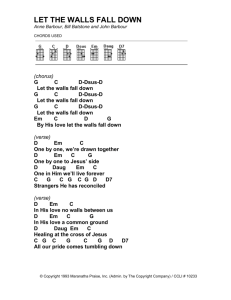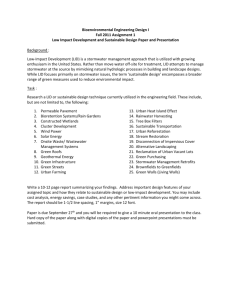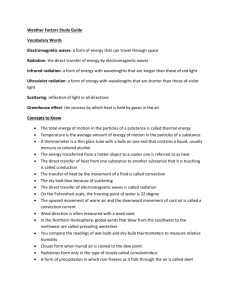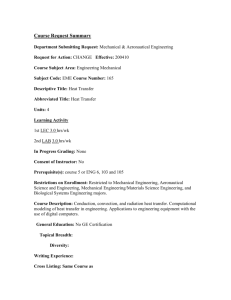SU-Home_Heating_Problem_Set_Solutions.doc
advertisement
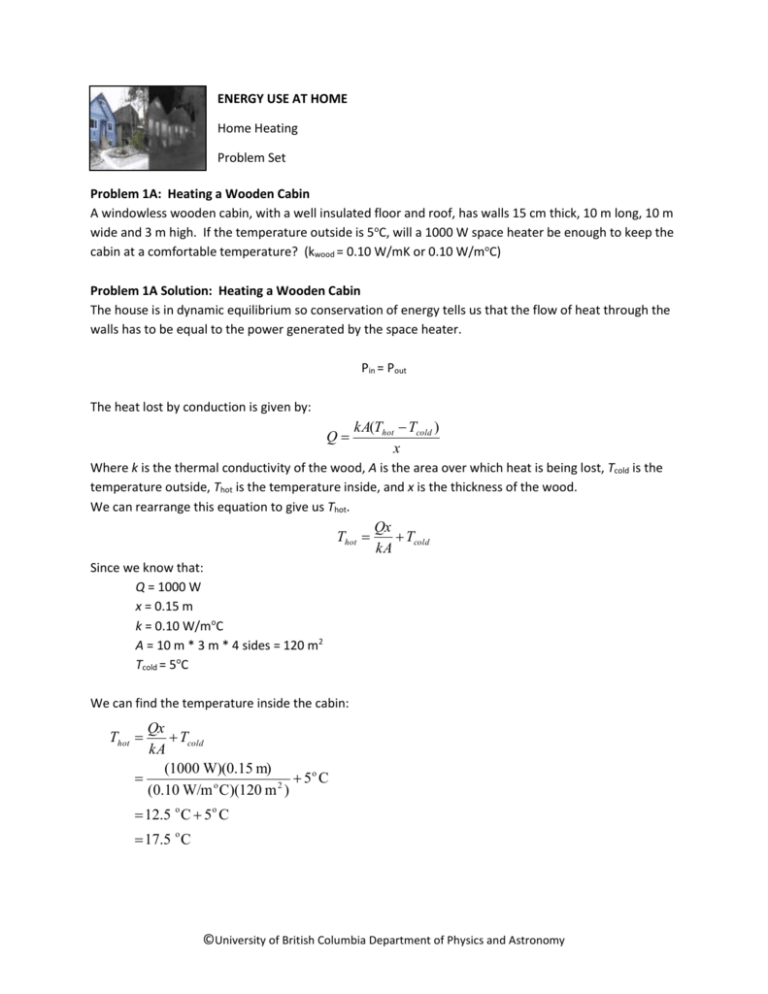
ENERGY USE AT HOME Home Heating Problem Set Problem 1A: Heating a Wooden Cabin A windowless wooden cabin, with a well insulated floor and roof, has walls 15 cm thick, 10 m long, 10 m wide and 3 m high. If the temperature outside is 5oC, will a 1000 W space heater be enough to keep the cabin at a comfortable temperature? (kwood = 0.10 W/mK or 0.10 W/moC) Problem 1A Solution: Heating a Wooden Cabin The house is in dynamic equilibrium so conservation of energy tells us that the flow of heat through the walls has to be equal to the power generated by the space heater. Pin = Pout The heat lost by conduction is given by: Q kA(Thot Tcold ) x Where k is the thermal conductivity of the wood, A is the area over which heat is being lost, Tcold is the temperature outside, Thot is the temperature inside, and x is the thickness of the wood. We can rearrange this equation to give us Thot. Thot Qx Tcold kA Since we know that: Q = 1000 W x = 0.15 m k = 0.10 W/moC A = 10 m * 3 m * 4 sides = 120 m2 Tcold = 5oC We can find the temperature inside the cabin: Qx Tcold kA (1000 W)(0.15 m) 5o C o 2 (0.10 W/m C)(120 m ) Thot 12.5 o C 5 o C 17.5 o C ©University of British Columbia Department of Physics and Astronomy So, the temperature inside the cabin is 17.5oC. Note, a real log cabin would have leaky windows and doors and so the heat loss would be considerably more and temperature inside would be much lower. Problem 1B: Heating a Wooden Cabin Two campers, who have consumed about 2200 Cal each today, spend their evening relaxing around the space heater. If all the calories are burned evenly in a 24 hour period, how much will their body heat contribute to the temperature inside the cabin? Problem 1B Solution: Heating a Wooden Cabin We know that 1 Cal (1 food calorie = 1kcal) is equal to 4200 J (see Useful Numbers article). So in one day they have consumed: 2200 Cal 2200 kcal ( 4200 J ) 9.24x10 6 J 1 kcal There are 86 400 seconds in a day. Knowing this we can calculate how much power this is equivalent to: 9.24x10 6 J 107 W 86400 s The human body produces power (for a man at rest) at a rate of 100 W (this can be altered by activity level). If more food is consumed than this, the calories get stored as fat and if less food is consumed, stored calories are burned, so in both cases the output remains similar. In this case, each camper produces power at a rate of about 100 W, and consumed about the same amount of calories as they burned. Adding this to the power produced by the space heater, we can calculate how this affects the temperature in the cabin. Qx Tcold kA (1200 W)(0.15 m) 5o C (0.10 W/m o C)(120 m 2 ) Thot 15 o C 5 o C 20 o C The temperature inside the cabin is now 20oC which a comfortable ambient temperature, but again, in a real cabin the temperature would be lower due to the leaky doors and windows. ©University of British Columbia Department of Physics and Astronomy Problem 2: Insulation A builder is going to build a house (10 m by 10 m and 3 m tall) with brick that is 4 inches thick and has an R-value of R-4. In an attempt to save money and energy, he only plans to keep his house heated from October to April where he will keep the temperature approximately 20oC warmer than it is outside. He is trying to decide whether or not he should insulate the exterior walls of his brick house. After a trip to his local hardware store, he finds that for approximately $55, he could insulate 75 ft2 with fibreglass insulation (R-20). Compare the predicted heat loss for his house with and without insulation and determine if it is worth it to insulate the exterior walls of his house Problem 2: Insulation Solution The cost of insulation: The area of his house will be 10 m x 3 m x 4 sides = 120 m2 Cost of buying insulation per m2: $55 1 ft ( Total insulation costs: ( Heat Lost: If there is only brick: 75 ft 2 )( 0.3048 m )2 $7.89 m2 $7.89 ) 120 m 2 $950 2 m Q AT (120 m 2 )( 20 K) 3400 W T R (4 R)(0.176 m 2 K / WR ) If the walls are insulated: Q AT (120 m 2 )( 20 K) 570 W T R (4 R 20 R)(0.176 m 2 K / WR ) The cost of electricity each year: In Vancouver, electricity costs $11/GJ * and our builder is only going to keep his house heated for 7 months each year. If there is only brick: J 30 days 24 h 60 min 60 s (3400 )(7 months)( )( )( )( ) s 1 month 1 day 1h 1 min $11 6.17x10 10 J( ) 1x10 9 J $700 If the walls are insulated: J 30 days 24 h 60 min 60 s (570 )(7 months)( )( )( )( ) s 1 month 1 day 1h 1 min $11 1.03x10 10 J( ) 1x10 9 J $100 ©University of British Columbia Department of Physics and Astronomy So, the builder will save approximately $600 a year if he insulates his house and so his savings will pay off the cost of the insulation in less than 2 years. * Terasen Gas. Rates (online). http://www.terasengas.com/Homes/Rates/default.htm?region=all [7 July 2010]. Problem 3: Radiation What happens to the heat after it has been conducted through the wall? Heat that is conducted to exterior walls is carried away by convection and radiation. On a winter’s evening with a low overcast sky, the cabin’s environment is equivalent to being surrounded by a black body of temperature 0oC. For the same house as problem 3, if the temperature of the surface of the house is 5oC, and it has an emissivity of 1.0, how much heat is lost due to radiation? Problem 3 Solution: Radiation We know: e = 1.0 σ = 5.67 x 10-8 W/m2K4 A = 120 m2 T2 = 11oC = 273 K T1 = 12oC = 278 K Heat lost to radiation: Q eA(T24 T14 ) T (1.0)(5.67 x 10 -8 W/m 2 K 4 )(120 m 2 )((278 K) 4 (273K) 4 ) 2,850 W We can see from this that radiation is a very effective way to get rid of heat once it has been conducted through the wall. Problem 4: Laptop in the Sun On a warm summer day, you leave your laptop computer out in plain sunlight for a few hours. The black plastic lid (A = 0.092 m2) is closed and is exposed to the sunlight. A) What is the total power on the lid due to the sun’s radiation? B) How much power is radiated by the lid at the equilibrium temperature? C) What is the surface equilibrium temperature of the lid? ©University of British Columbia Department of Physics and Astronomy Problem 4 Solution: Laptop in the Sun A) What is the total power on the lid due to the sun’s radiation? The solar constant describes the power of the sun per m2, S = 1367 W/m2. The lid absorbs: P (1367 W/m 2 )(0.092 m 2 ) 126 W B) How much power is radiated by the lid at the equilibrium temperature? At equilibrium temperature Pin = Pout. The incoming power is the one calculated in (A) and the outgoing power is due to the temperature of the lid due to the Stefan Boltzmann law. Pout eAT 4 126 W C) What is the surface equilibrium temperature of the lid? In this case there is no To since the environmental temperature is mainly radiated by nearby objects and if the laptop is on an open area, nothing can radiate back to the top of the lid. Pout eσeσ T4 4 126 W 126 W eσσ 126 W (1)(5.67x1 0 W/m 2 K)(0.092 m 2 ) 394 W 8 Problem 5: The Heating of a House For the following question, use the dimensions and characteristics of your own house. It is reasonable to assume that walls are thick enough to block direct heat loss to radiations (without prior conduction through the walls). Windows are relatively thin in comparison and conduct more heat than walls (i.e. a double-pane glazed window has a typical value of R-2). A) How much heat is lost due to conduction? B) How much heat is radiated directly (without conduction)? C) How much heat is lost through convection (you can assume the air is completely exchanged 3 times / day if you don’t know this value for your own house). D) What is the total heat loss? What are the shortcomings of your model? E) Electrical energy is typically generated in coal-fired power plants which emit approximately 1.55 lbs (0.703 kg) of CO2 per kWh produced*. How much money would heating your house require and how much CO2 would it produce each day? Each year? F) How much money and CO2 could you save by lowering the temperature by 1oC? *Energy Star. Life Cycle Cost Estimate for ENERGY STAR Qualified Dehumidifiers Assumptions (online). http://www.energystar.gov/ia/business/bulk_purchasing/bpsavings_calc/CalculatorConsumerDehumidi fier.xls [7 July 2010]. ©University of British Columbia Department of Physics and Astronomy Problem 5 Solution: The Heating of a House For the following question, use the dimensions and characteristics of your own house. It is reasonable to assume that walls are thick enough to block direct heat loss to radiations (without prior conduction through the walls). Windows are relatively thin in comparison and conduct more heat than walls (i.e. a double-pane glazed window has a typical value of R-2). For our answers we will use a house (5 m tall) with 10 m2 of windows (R-2), 90 m2 of walls (R-20), and an average temperature difference of 10oC (20oC inside, 10oC outside). A) How much heat is lost due to conduction? Walls: A = 90 m2 𝛥T = 10 K R-20 Windows: A = 10 m2 𝛥T = 10 K R-2 Q AT (90 m 2 )(10 K) 256 W T R (20 R)(0.176 m 2 K / WR ) Q AT (10 m 2 )(10 K) 284 W T R (2 R)(0.176 m 2 K / WR ) Overall, 540 W are lost to conduction. B) How much heat is radiated directly (without conduction)? Recall that the walls are thick enough to block direct heat loss due to radiation. Windows: Q eA(T24 T14 ) e = 1.0 T A = 10 m2 (1.0)(5.67 x 10 -8 W/m 2 K 4 )(10 m 2 )((293 K) 4 (283 K) 4 ) o Tin = 293 K (20 C) 542 W Tout = 283 (10oC) But, only about half of this heat is lost because the other half is radiated back into the room (remember the basis of the greenhouse effect). So, the heat loss to radiation is 270 W. C) How much heat is lost through convection (you can assume the air is completely exchanged 3 times / day if you don’t know this value for your own house). Volume = (90 m2 + 10 m2)(5 m) = 500 m3 Volume of air exchanged each day = (500 m3)(3) = 1500 m3 𝛥T = 10 K Specific Heat Capacity of Air, c = 1005 KJ/kg⦁K Density of air, ρ = 1.2 kg/m3 ©University of British Columbia Department of Physics and Astronomy Heat, Q cTV (1005 KJ kg )(10 K)(1.2 3 )(1500 m 3 ) kgK m 18 MJ Power Q t 18 MJ 208 W min s (24 h)(60 )(60 ) h min Through convection, 210 W are lost. D) What is the total heat loss? What are the shortcomings of your model? Thermal energy lost: Conduction: 540 W Radiation: 270 W Convection: + 210 W Total: 1020 W In this model, we did not account for ventilation, cracks or the opening of doors or windows and we also ignored heat loss through the floor and ceiling. E) Electrical energy is typically generated in coal-fired power plants which emit approximately 1.55 lbs (0.703 kg) of CO2 per kWh produces*. How much money would heating your house require and how much CO2 would it produce each day? Each year? Terasen Gas charges ~$11/GJ * Each day: Energy (Power) (time) min s )(60 ) h min 8.8 x 10 7 0.088 GJ CO 2 : (1.02 kW)(24 h)( 0.703 kg ) 17.2 kg kWh (1020 W)( 24 h)(60 Cost (Rate) (Energy) ( $11 )(0.088 GJ ) $0.97 1 GJ Each year: Cost ≈ $355, CO2: 6200 kg * Terasen Gas. Rates (online). http://www.terasengas.com/Homes/Rates/default.htm?region=all [7 July 2010]. ©University of British Columbia Department of Physics and Astronomy F) How much money and CO2 could you save by lowering the temperature inside by 1oC? (we will lower it to 19oC). Conduction: Walls: Q AT (90 m 2 )(9 K) 230 W T R (20 R)(0.176 m 2 K / WR ) Windows: Q AT (10 m 2 )(9 K) 256 W T R (2 R)(0.176 m 2 K / WR ) Radiation: Q eA(T24 T14 ) T (1.0)(5.67 x 10 -8 W/m 2 K 4 )(10 m 2 )((292 K) 4 (283 K) 4 ) 485 W 243 W (because half of it is radiated back into the house) Convection: Q cTV ΔT t kJ kg )(9 K)(1.2 3 )(1500 m 3 ) kgK m min s (24 h)(60 )(60 ) h min (1005 188 W Thermal energy lost: Conduction: 486 W Radiation: 243 W Convection: + 188 W Total: 917 W Cost (Rate) (Energy) ( $11 min s 1 GJ )(920 W)( 24 h)(60 )(60 )( ) $0.87 1 GJ h min 1 x 10 9 J CO 2 : (0.92 kW)(24 h)( 0.703 kg ) 15.5 kg kWh Savings: Cost: $0.10/day – $36 / year CO2: 1.7 kg/day – 640 kg/year Andrzej Kotlicki, Georg Rieger and Brittany Tymos 2010-07-15 ©University of British Columbia Department of Physics and Astronomy ©University of British Columbia Department of Physics and Astronomy



